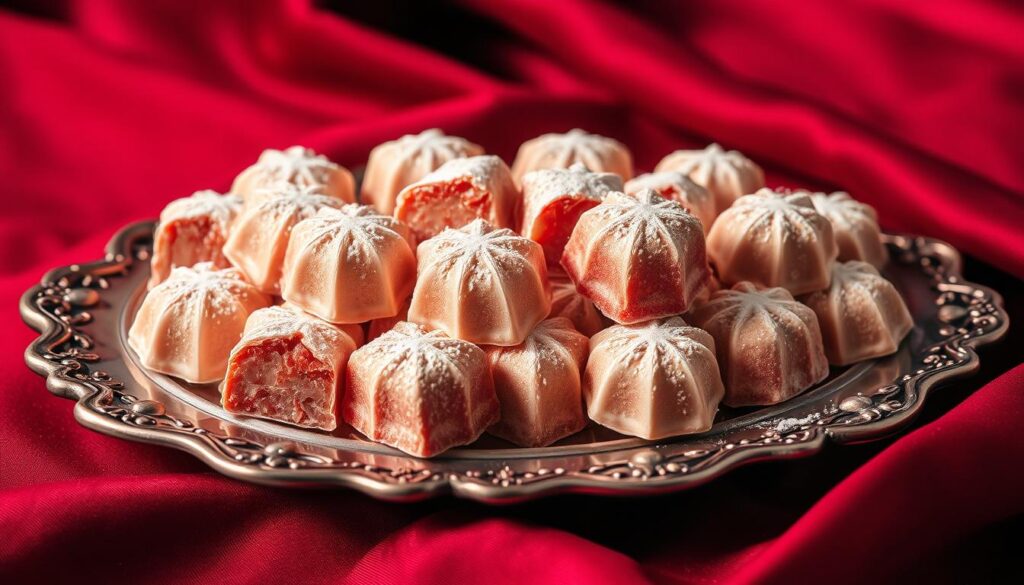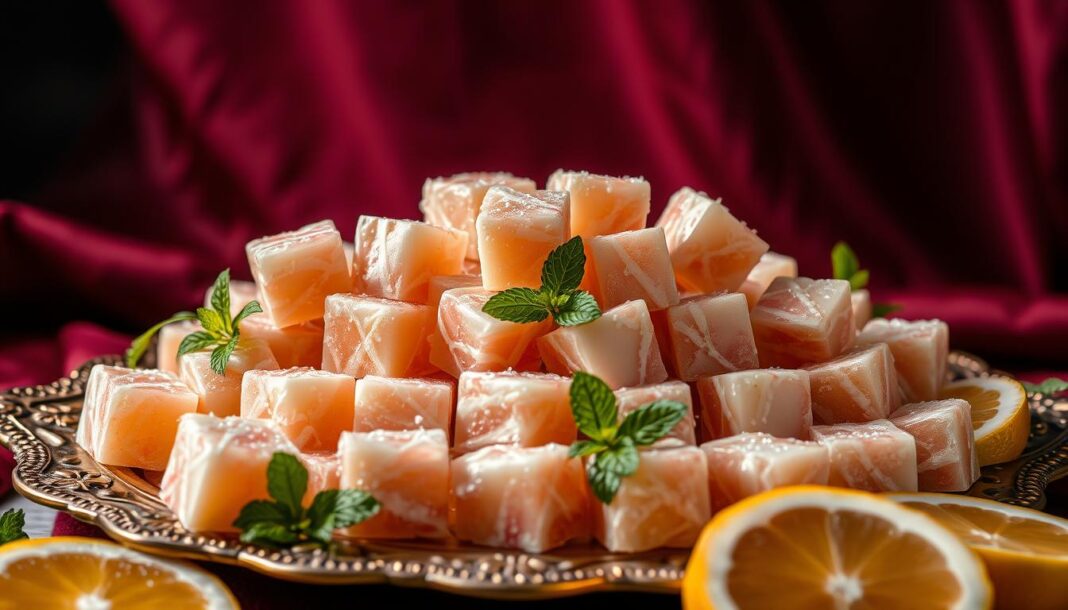In C.S. Lewis’s beloved Chronicles of Narnia series, a magical confectionery plays a pivotal role in tempting Edmund Pevensie into betraying his siblings. This sweet treat, known as Turkish Delight, has captivated readers and viewers alike since its introduction in The Lion, The Witch and The.
We will explore the enchanting world of this gummy treat, which originated in Turkey and has a texture between gumdrops and Jell-O. Made from a gel created by heating sugar and starch, it’s a confection that has become iconic in both literature and culinary tradition.
Key Takeaways
- Discover the historical significance of Turkish Delight in literature and culinary tradition.
- Learn how to make authentic Turkish Delights using our meticulously tested recipe.
- Understand the cultural context behind C.S. Lewis’s choice of Turkish Delight as the White Witch’s temptation.
- Explore the magical allure of this confection and its role in the Narnia universe.
- Gain insights into balancing traditional methods with accessible techniques for home cooks.
The Magical Allure of Turkish Delights in Narnia
The enchanting world of Narnia, as depicted in C.S. Lewis’s Chronicles of Narnia, has captivated readers with its magical elements, among which Turkish Delight stands out as a symbol of temptation. This sweet treat plays a pivotal role in The Lion, The Witch and The Wardrobe, enticing Edmund Pevensie with its magical properties.
Edmund’s Temptation in The Lion, The Witch and The Wardrobe
In the story, the White Witch uses Turkish Delight to tempt Edmund, one of the four Pevensie children, into tricking the rest of his siblings into returning to the mysterious world behind the Wardrobe. As noted in an article on The Independent, this scene is crucial as it demonstrates how easily one can be tempted by immediate gratification, a theme C.S. Lewis carefully crafted into his narrative.
The psychological impact of the Turkish Delight scene resonates with readers because it highlights the human vulnerability to temptation, making it a powerful symbol in the narrative.
C.S. Lewis and His Inspiration
We explore C.S. Lewis’s personal relationship with sweets and confections, investigating whether his own childhood experiences influenced his decision to use Turkish Delight as the witch’s tempting treat. The cultural significance of Turkish Delight as a foreign and somewhat mysterious confection in mid-20th century England made it the perfect vehicle for Lewis to convey otherworldliness and magical allure.
Lewis’s use of Turkish Delight not only adds a layer of magic to the story but also serves as a reminder of the power of treats to influence our actions and decisions.
The Rich History of Turkish Delights
As we explore the history of Turkish Delights, we uncover a narrative that is both deeply rooted in Turkish heritage and universally appealing. Turkish Delights, also known as lokum, have been a beloved treat for centuries, captivating the hearts of many around the world with their unique texture and flavor.

Origins in Turkey: The Story of Lokum
The story of Turkish Delight begins in Turkey, where it was first created in the late 18th century by confectioner Bekir Efendi. He developed this unique confection by heating sugar syrup and a cornstarch slurry mixture until it thickened into a gel, which was then flavored with rosewater and sometimes included add-ins like pistachios or walnuts.
The traditional preparation methods for lokum have remained remarkably consistent over the years, with the fundamental technique of combining sugar syrup with starch to create a gel-like consistency still forming the basis of authentic recipes today.
How Turkish Delights Became a Global Treat
As trade routes expanded and exotic foods became fashionable among the upper classes, Turkish Delight spread beyond Turkey’s borders to become a global phenomenon. It gained popularity in Victorian England, where it was enjoyed as a luxurious treat among the elite.
The cultural significance of Turkish Delight varies across different regions. In the Middle East, it’s enjoyed as a daily sweet, while in Western countries, it’s often reserved for special occasions. Understanding the historical context of Turkish Delight helps appreciate why it was such an effective literary device in C.S. Lewis’s work, representing something both foreign and luxurious to British children of the 1940s.
Authentic Narnia Turkish Delights: Our Complete Recipe
In our quest to recreate the iconic Narnia Turkish Delights, we’ve distilled the process into a clear, step-by-step guide. Making these magical treats involves understanding the science behind their creation and using traditional methods with accessible ingredients.
Essential Ingredients and Equipment
To make authentic Turkish Delights, you’ll need specific ingredients and equipment. Our ingredient list focuses on creating the perfect texture and flavor profile, using granulated sugar for sweetness, cornstarch for structure, water for dissolving, citric acid for balance, and authentic flavorings like rosewater that align with traditional Turkish preparation methods.
The equipment section details why specific tools are crucial: a heavy-bottomed pot prevents scorching during the extended cooking process, a candy thermometer ensures precise temperature control, and proper setting containers affect the final texture.
| Ingredient | Quantity | Purpose |
|---|---|---|
| Granulated Sugar | 1 cup | Sweetness |
| Cornstarch | 1/2 cup | Structure |
| Water | 1 cup | Dissolving |
| Citric Acid | 1 tsp | Balance |
| Rosewater | 1 tsp (optional) | Flavoring |
Step-by-Step Preparation Guide
Creating Turkish Delights involves several critical steps. First, we need to make the sugar syrup, then prepare the cornstarch slurry, and finally combine and cook the mixture to achieve the perfect lokum.
Making the Sugar Syrup
Start by combining sugar, citric acid, and water in a heavy-bottomed pot. Whisk until the sugar is fully dissolved, then let it simmer without stirring until it reaches 250°F on a candy thermometer. This precise temperature is crucial for achieving the soft-ball stage, which gives Turkish Delights their characteristic gel-like consistency.

In a separate bowl, mix cornstarch with a small amount of water until it’s smooth and free of lumps. This mixture is then gradually added to the sugar syrup, requiring careful temperature control to prevent lumps from forming.
Combining and Cooking the Lokum
The final step involves combining the sugar syrup and cornstarch slurry, cooking the mixture over heat for several minutes until it thickens. The mixture is then poured into a setting container, allowed to cool, and cut into pieces. Finally, the Turkish Delights are dredged in powdered sugar to prevent sticking.
By following these steps and using the right ingredients and equipment, you’ll be able to create authentic Narnia Turkish Delights that capture the magic described in The Lion, The Witch and The Wardrobe.
Master Tips for Perfect Turkish Delights
Mastering the craft of Turkish Delights involves understanding the critical factors that influence their quality. At Historical Foods, we’ve distilled our knowledge into key areas that ensure success in creating these delightful confections.
Temperature Control: The Key to Success
Temperature control is paramount when making Turkish Delights. Using a candy thermometer is essential to reach the precise temperature of 250°F, which is crucial for achieving the right set and texture. This attention to detail ensures that your delights have the perfect consistency.
Maintaining the correct heat is not just about reaching a specific temperature; it’s also about consistency throughout the cooking process. We recommend keeping the mixture at a steady heat to prevent it from becoming too thick or too thin.
Flavoring Options Beyond Rosewater
While rosewater is the traditional flavoring for Turkish Delights, there are numerous other options to explore. Orange blossom water, bergamot, pistachio, and pomegranate are just a few alternatives that can add unique twists to your delights. When experimenting with new flavors, start with small amounts to ensure the taste is balanced.
It’s also worth noting that the quality of your flavorings can significantly impact the final product. Opt for high-quality, food-grade ingredients to get the best out of your Turkish Delights.
Cutting and Storing Your Turkish Delights
Once your Turkish Delights are set, cutting them into manageable pieces can be a challenge. Dusting your cutting tool with powdered sugar can help prevent sticking and ensure clean cuts. For storage, keep your delights in an airtight container, layered between sheets of parchment paper and generously dusted with powdered sugar to prevent sticking.
Proper storage is crucial for maintaining the quality of your Turkish Delights over time. Store them at room temperature, away from direct sunlight and moisture, to enjoy them for weeks to come.
Experiencing the Magic of Homemade Turkish Delights
As we conclude our exploration of Narnia’s Turkish Delights, it’s clear that this sweet treat has captured the hearts of many, both in fiction and reality. Making Turkish Delights at home is a journey that combines patience, creativity, and a touch of magic. We believe that sharing these homemade treats with friends and family creates a memorable experience that goes beyond mere confectionery.
The process of crafting these chewy, powdered sugar-coated gems allows us to connect with the story of Narnia on a deeper level. By introducing children to literature through associated foods, we create powerful memory connections that enhance comprehension and enjoyment. Whether you’re revisiting the classic tale or experiencing it for the first time, our recipe provides an authentic sensory experience.
So, grab a piece, close your eyes, and let the taste transport you to a world where anything is possible. With every bite of these delightful Turkish Delights, you’re not just savoring a sweet treat; you’re experiencing a bit of Narnia’s magic.


